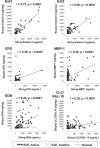One-Hour Esophageal String Test: A Nonendoscopic Minimally Invasive Test That Accurately Detects Disease Activity in Eosinophilic Esophagitis
- PMID: 31567192
- PMCID: PMC6784776
- DOI: 10.14309/ajg.0000000000000371
One-Hour Esophageal String Test: A Nonendoscopic Minimally Invasive Test That Accurately Detects Disease Activity in Eosinophilic Esophagitis
Abstract
Objectives: Eosinophilic esophagitis (EoE), a chronic food allergic disease, lacks sensitive and specific peripheral biomarkers. We hypothesized that levels of EoE-related biomarkers captured using a 1-hour minimally invasive Esophageal String Test (EST) would correlate with mucosal eosinophil counts and tissue concentrations of these same biomarkers. We aimed to determine whether a 1-hour EST accurately distinguishes active from inactive EoE or a normal esophagus.
Methods: In a prospective, multisite study, children and adults (ages 7-55 years) undergoing a clinically indicated esophagogastroduodenoscopy performed an EST with an esophageal dwell time of 1 hour. Subjects were divided into 3 groups: active EoE, inactive EoE, and normal esophageal mucosa. Eosinophil-associated protein levels were compared between EST effluents and esophageal biopsy extracts. Statistical modeling was performed to select biomarkers that best correlated with and predicted eosinophilic inflammation.
Results: One hundred thirty-four subjects (74 children, 60 adults) with active EoE (n = 62), inactive EoE (n = 37), and patient controls with a normal esophagus (n = 35) completed the study. EST-captured eosinophil-associated biomarkers correlated significantly with peak eosinophils/high-power field, endoscopic visual scoring, and the same proteins extracted from mucosal biopsies. Statistical modeling, using combined eotaxin-3 and major basic protein-1 concentrations, led to the development of EoE scores that distinguished subjects with active EoE from inactive EoE or normal esophagi. Eighty-seven percent of children, 95% of parents, and 92% of adults preferred the EST over endoscopy if it provided similar information.
Discussion: The 1-hour EST accurately distinguishes active from inactive EoE in children and adults and may facilitate monitoring of disease activity in a safe and minimally invasive fashion.
Figures





Similar articles
-
The Minimally Invasive 1-Hour Esophageal String Test Monitors Therapeutic Changes in Mucosal Inflammation in Eosinophilic Esophagitis.Am J Gastroenterol. 2025 Jan 1;120(1):254-258. doi: 10.14309/ajg.0000000000003192. Epub 2024 Nov 6. Am J Gastroenterol. 2025. PMID: 39503361
-
The oesophageal string test: a novel, minimally invasive method measures mucosal inflammation in eosinophilic oesophagitis.Gut. 2013 Oct;62(10):1395-405. doi: 10.1136/gutjnl-2012-303171. Epub 2012 Aug 15. Gut. 2013. PMID: 22895393 Free PMC article.
-
Longitudinal Evaluation of Noninvasive Biomarkers for Eosinophilic Esophagitis.J Clin Gastroenterol. 2017 Feb;51(2):127-135. doi: 10.1097/MCG.0000000000000621. J Clin Gastroenterol. 2017. PMID: 27479142
-
Minimally invasive biomarker studies in eosinophilic esophagitis: A systematic review.Ann Allergy Asthma Immunol. 2018 Aug;121(2):218-228. doi: 10.1016/j.anai.2018.05.005. Epub 2018 May 16. Ann Allergy Asthma Immunol. 2018. PMID: 29753832 Free PMC article.
-
Eosinophilic esophagitis.Allergy Asthma Proc. 2019 Nov 1;40(6):462-464. doi: 10.2500/aap.2019.40.4272. Allergy Asthma Proc. 2019. PMID: 31690395 Review.
Cited by
-
Noninvasive Diagnosis of Eosinophilic Esophagitis: The Nuclear Medicine Option.Mayo Clin Proc. 2020 Mar;95(3):432-434. doi: 10.1016/j.mayocp.2020.01.025. Mayo Clin Proc. 2020. PMID: 32138872 Free PMC article. No abstract available.
-
Searching for Noninvasive Predictors of the Diagnosis and Monitoring of Eosinophilic Esophagitis-The Importance of Biomarkers of the Inflammatory Reaction Involving Eosinophils.Biomolecules. 2021 Jun 15;11(6):890. doi: 10.3390/biom11060890. Biomolecules. 2021. PMID: 34203871 Free PMC article. Clinical Trial.
-
Minimally Invasive Approaches to Diagnose and Monitor Eosinophilic GI Diseases.Curr Allergy Asthma Rep. 2024 May;24(5):269-279. doi: 10.1007/s11882-024-01142-0. Epub 2024 Mar 27. Curr Allergy Asthma Rep. 2024. PMID: 38536531 Review.
-
Orodispersible budesonide tablets for the treatment of eosinophilic esophagitis: a review of the latest evidence.Therap Adv Gastroenterol. 2020 Jun 10;13:1756284820927282. doi: 10.1177/1756284820927282. eCollection 2020. Therap Adv Gastroenterol. 2020. PMID: 32565912 Free PMC article. Review.
-
Non-invasive biomarkers to diagnose and monitor eosinophilic esophagitis: a systematic review.Front Med (Lausanne). 2025 Jun 26;12:1607306. doi: 10.3389/fmed.2025.1607306. eCollection 2025. Front Med (Lausanne). 2025. PMID: 40641963 Free PMC article.
References
Publication types
MeSH terms
Substances
Grants and funding
LinkOut - more resources
Full Text Sources
Medical
Research Materials

